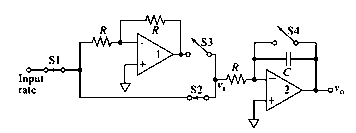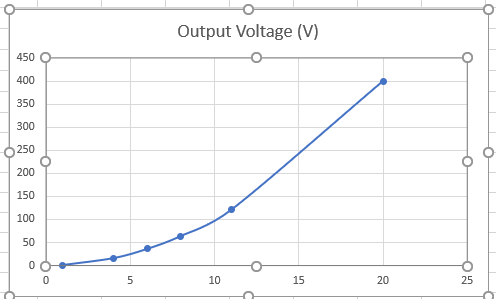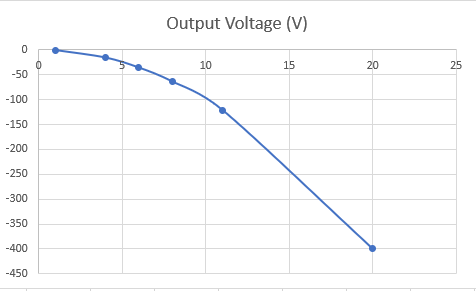
(a)
Interpretation:
The function of the operational amplifier 1 should be determined.
Concept introduction:
The operational amplifier is a high gain device and it amplifies the voltage. Generally, a voltage amplifier has a single output and differential input. So, basically, an operational amplifier produces an output much higher than the input voltage. The output voltage could be thousands of times higher than the input voltage.
Here, the given electronic circuit is as below:

Explanation of Solution
Given information:

The operational amplifier is a high gain device and it amplifies the voltage. Generally, a voltage amplifier has a single output and differential input. So basically, an operational amplifier produces an output much higher than the input voltage. The output voltage could be thousands of times higher than the input voltage.
Here the given electronic circuit is as below:

It can be seen that the operational amplifier 1 here performing the function of inverting voltage amplifier.
(b)
Interpretation:
The function of the operational amplifier 2 should be determined.
Concept introduction:
The operational amplifier is a high gain device and it amplifies the voltage. Generally, a voltage amplifier has a single output and differential input. So, basically, an operational amplifier produces an output much higher than the input voltage. The output voltage could be thousands of times higher than the input voltage.
Here the given electronic circuit is as below

Explanation of Solution
The operational amplifier is a high gain device and it amplifies the voltage. Generally, a voltage amplifier has a single output and differential input. So basically, an operational amplifier produces an output much higher than the input voltage. The output voltage could be thousands of times higher than the input voltage.
Here the given electronic circuit is as below:

It can be seen that the operational amplifier 2 here performing the function of integrating circuit and hence the integration.
(c)
Interpretation:
The output voltage during the interval
Concept introduction:
The operational amplifier is a high gain device and it amplifies the voltage. Generally, a voltage amplifier has a single output and differential input. So, basically, an operational amplifier produces an output much higher than the input voltage. The output voltage could be thousands of times higher than the input voltage.
Here the given electronic circuit is as below

Explanation of Solution
The operational amplifier is a high gain device and it amplifies the voltage. Generally, a voltage amplifier has a single output and differential input. So basically, an operational amplifier produces an output much higher than the input voltage. The output voltage could be thousands of times higher than the input voltage.
Here the given electronic circuit is as below:

Here the input voltage
Where
As per the problem switches
Here, the output signal can be given by the formula as below
Now assume
Substitute the values in the above equation and simplify, the result obtained is
The integrating voltage at different time intervals is given as:
| Time(s) | Output Voltage (V) |
| 1 | 1 |
| 4 | 16 |
| 6 | 36 |
| 8 | 64 |
| 11 | 121 |
| 20 | 40 |
The plot can be obtained as shown below:

(d)
Interpretation:
The output voltage during the second interval
Concept introduction:
The operational amplifier is a high gain device and it amplifies the voltage. Generally, a voltage amplifier has a single output and differential input. So, basically, an operational amplifier produces an output much higher than the input voltage. The output voltage could be thousands of times higher than the input voltage.
Here the given electronic circuit is as below

Explanation of Solution
The operational amplifier is a high gain device and it amplifies the voltage. Generally, a voltage amplifier has a single output and differential input. So basically, an operational amplifier produces an output much higher than the input voltage. The output voltage could be thousands of times higher than the input voltage.
Here the given electronic circuit is as below

Here the input voltage
Where
As per the problem switches
Here the output signal can be given by the formula as below
Where
Therefore, it can be said that
The output of the second operational amplifier which is actually the final output can be given by the equation as below:
Where
Now assume
Substitute the values in the above equation and simplify, the result obtained is
The integrating voltage at different time intervals is given as:
| Time(s) | Output Voltage (V) |
| 1 | -1 |
| 4 | -16 |
| 6 | -36 |
| 8 | -64 |
| 11 | -121 |
| 20 | -40 |
The plot can be obtained as shown below:

(e)
Interpretation:
The output voltage
Concept introduction:
The operational amplifier is a high gain device and it amplifies the voltage. Generally, a voltage amplifier has a single output and differential input. So, basically, an operational amplifier produces an output much higher than the input voltage. The output voltage could be thousands of times higher than the input voltage.
Here the given electronic circuit is as below

Explanation of Solution
The operational amplifier is a high gain device and it amplifies the voltage. Generally, a voltage amplifier has a single output and differential input. So basically, an operational amplifier produces an output much higher than the input voltage. The output voltage could be thousands of times higher than the input voltage.
Here the given electronic circuit is as below

Since there is no current so capacitor will discharge. And circuit will act as differentiator.
Further, it can be re-written as
The output can be given as
(f)
Interpretation:
The advantages and disadvantages of the given circuit over the normal amplifier should be described.
Concept introduction:
The operational amplifier is a high gain device and it amplifies the voltage. Generally, a voltage amplifier has a single output and differential input. So, basically, an operational amplifier produces an output much higher than the input voltage. The output voltage could be thousands of times higher than the input voltage.
Here the given electronic circuit is as below

Explanation of Solution
The operational amplifier is a high gain device and it amplifies the voltage. Generally, a voltage amplifier has a single output and differential input. So basically, an operational amplifier produces an output much higher than the input voltage. The output voltage could be thousands of times higher than the input voltage.
Here the given electronic circuit is as below

Since there is no current so capacitor will discharge. And circuit will act as differentiator.
In general, the normal operational amplifier circuit can be used as a differentiator circuit only. But the given integrating circuit can be used as differentiator as well as integrator. Just one disadvantage is that the given circuit has higher noise level as compared to the normal circuit.
(g)
Interpretation:
The scenario if the input signal gets changes with the slope during the measurement cycle should be determined.
Concept introduction:
The operational amplifier is a high gain device and it amplifies the voltage. Generally, a voltage amplifier has a single output and differential input. So, basically, an operational amplifier produces an output much higher than the input voltage. The output voltage could be thousands of times higher than the input voltage.
Here the given electronic circuit is as below

Explanation of Solution
The operational amplifier is a high gain device and it amplifies the voltage. Generally, a voltage amplifier has a single output and differential input. So basically, an operational amplifier produces an output much higher than the input voltage. The output voltage could be thousands of times higher than the input voltage.
Here the given electronic circuit is as below

Since there is no current so capacitor will discharge. And circuit will act as differentiator.
The output of the second operational amplifier which is actually the final output can be given by the equation as below:
Where
Now assume
Substitute the values in the above equation and simplify, the result obtained is
Further it can be written that
(h)
Interpretation:
The result obtained if the two-time intervals are separated by a time delay
Concept introduction:
The operational amplifier is a high gain device and it amplifies the voltage. Generally, a voltage amplifier has a single output and differential input. So, basically, an operational amplifier produces an output much higher than the input voltage. The output voltage could be thousands of times higher than the input voltage.
Here the given electronic circuit is as below

Explanation of Solution
The operational amplifier is a high gain device and it amplifies the voltage. Generally, a voltage amplifier has a single output and differential input. So basically, an operational amplifier produces an output much higher than the input voltage. The output voltage could be thousands of times higher than the input voltage.
Here the given electronic circuit is as below

For the given circuit the during the first time interval
Now if the two-time intervals are separated by a time delay
(i)
Interpretation:
The result if the two-time intervals were of different duration should be determined.
Concept introduction:
The operational amplifier is a high gain device and it amplifies the voltage. Generally, a voltage amplifier has a single output and differential input. So, basically, an operational amplifier produces an output much higher than the input voltage. The output voltage could be thousands of times higher than the input voltage.
Here the given electronic circuit is as below

Explanation of Solution
The operational amplifier is a high gain device and it amplifies the voltage. Generally, a voltage amplifier has a single output and differential input. So basically, an operational amplifier produces an output much higher than the input voltage. The output voltage could be thousands of times higher than the input voltage.
Here the given electronic circuit is as below

As its known that, if the two-time intervals are same then the plot of the output voltage is same in magnitude and opposite in sign for both the interval. But if the two-time intervals are of different duration then the magnitude of output signal will be different for both the time periods.
(j)
Interpretation:
The reason should be discussed for why the time interval is desirable to be as large as possible in measuring enzyme
Concept introduction:
The operational amplifier is a high gain device and it amplifies the voltage. Generally, a voltage amplifier has a single output and differential input. So, basically, an operational amplifier produces an output much higher than the input voltage. The output voltage could be thousands of times higher than the input voltage.
Here the given electronic circuit is as below:

Explanation of Solution
The operational amplifier is a high gain device and it amplifies the voltage. Generally, a voltage amplifier has a single output and differential input. So basically, an operational amplifier produces an output much higher than the input voltage. The output voltage could be thousands of times higher than the input voltage.
Here the given electronic circuit is as below

Since there is no current so capacitor will discharge. And circuit will act as differentiator.
The output of the second operational amplifier which is actually the final output can be given by the equation as below:
Where
Now, assume
Substitute the values in the above equation and simplify, the result obtained is
If the time gets larger then the output voltage also gets larger.
Enzyme kinematics are generally time-consuming process. So, its desirable to have larger time.
Want to see more full solutions like this?
Chapter 3 Solutions
Principles of Instrumental Analysis
- Epoxides can be opened in aqueous acid or aqueous base to produce diols (molecules with two OH groups). In this question, you'll explore the mechanism of epoxide opening in aqueous acid. 2nd attempt Be sure to show all four bonds at stereocenters using hash and wedge lines. 0 0 Draw curved arrows to show how the epoxide reacts with hydronium ion. 100 +1: 1st attempt Feedback Be sure to show all four bonds at stereocenters using hash and wedge lines. See Periodic Table See Hint H A 5 F F Hr See Periodic Table See Hintarrow_forward03 Question (1 point) For the reaction below, draw both of the major organic products. Be sure to consider stereochemistry. > 1. CH₂CH₂MgBr 2. H₂O 3rd attempt Draw all four bonds at chiral centers. Draw all stereoisomers formed. Draw the structures here. e 130 AN H See Periodic Table See Hint P C Brarrow_forwardYou may wish to address the following issues in your response if they are pertinent to the reaction(s) you propose to employ:1) Chemoselectivity (why this functional group and not another?) 2) Regioselectivity (why here and not there?) 3) Stereoselectivity (why this stereoisomer?) 4) Changes in oxidation state. Please make it in detail and draw it out too in what step what happens. Thank you for helping me!arrow_forward
- 1) Chemoselectivity (why this functional group and not another?) 2) Regioselectivity (why here and not there?) 3) Stereoselectivity (why this stereoisomer?) 4) Changes in oxidation state. Everything in detail and draw out and write it.arrow_forwardCalculating the pH at equivalence of a titration 3/5 Izabella A chemist titrates 120.0 mL of a 0.7191M dimethylamine ((CH3)2NH) solution with 0.5501 M HBr solution at 25 °C. Calculate the pH at equivalence. The pk of dimethylamine is 3.27. Round your answer to 2 decimal places. Note for advanced students: you may assume the total volume of the solution equals the initial volume plus the volume of HBr solution added. pH = ☐ ✓ 18 Ar Boarrow_forwardAlcohols can be synthesized using an acid-catalyzed hydration of an alkene. An alkene is combined with aqueous acid (e.. sulfuric acid in water). The reaction mechanism typically involves a carbocation intermediate. > 3rd attempt 3343 10 8 Draw arrows to show the reaction between the alkene and hydronium ion. that 2nd attempt Feedback 1st attempt تعمال Ju See Periodic Table See Hint F D Ju See Periodic Table See Hintarrow_forward
- Draw the simplified curved arrow mechanism for the reaction of acetone and CHgLi to give the major product. 4th attempt Π Draw the simplified curved arrow mechanism T 3rd attempt Feedback Ju See Periodic Table See Hint H -H H -I H F See Periodic Table See Hintarrow_forwardSelect the correct reagent to accomplish the first step of this reaction. Then draw a mechanism on the Grignard reagent using curved arrow notation to show how it is converted to the final product. 4th attempt Part 1 (0.5 point) Select the correct reagent to accomplish the first step of this reaction. Choose one: OA Mg in ethanol (EtOH) OB. 2 Li in THF O C. Li in THF D. Mg in THF O E Mg in H2O Part 2 (0.5 point) Br Part 1 Bri Mg CH B CH, 1 Draw intermediate here, but no arrows. © TE See Periodic Table See Hint See Hint ין Harrow_forwardSelect the product for the following reaction. HO HO PCC OH ○ OH O HO ○ HO HO HOarrow_forward
- 5:45 Х Select the final product for the following reaction sequence. O O 1. Mg. ether 2.D.Oarrow_forwardBased on the chart Two similarities between the molecule with alpha glycosidic linkages. Two similarities between the molecules with beta glycosidtic linkages. Two differences between the alpha and beta glycosidic linkages.arrow_forwardplease help fill in the tablearrow_forward
 Physical ChemistryChemistryISBN:9781133958437Author:Ball, David W. (david Warren), BAER, TomasPublisher:Wadsworth Cengage Learning,
Physical ChemistryChemistryISBN:9781133958437Author:Ball, David W. (david Warren), BAER, TomasPublisher:Wadsworth Cengage Learning, Chemistry for Engineering StudentsChemistryISBN:9781285199023Author:Lawrence S. Brown, Tom HolmePublisher:Cengage Learning
Chemistry for Engineering StudentsChemistryISBN:9781285199023Author:Lawrence S. Brown, Tom HolmePublisher:Cengage Learning Principles of Instrumental AnalysisChemistryISBN:9781305577213Author:Douglas A. Skoog, F. James Holler, Stanley R. CrouchPublisher:Cengage Learning
Principles of Instrumental AnalysisChemistryISBN:9781305577213Author:Douglas A. Skoog, F. James Holler, Stanley R. CrouchPublisher:Cengage Learning Principles of Modern ChemistryChemistryISBN:9781305079113Author:David W. Oxtoby, H. Pat Gillis, Laurie J. ButlerPublisher:Cengage Learning
Principles of Modern ChemistryChemistryISBN:9781305079113Author:David W. Oxtoby, H. Pat Gillis, Laurie J. ButlerPublisher:Cengage Learning




